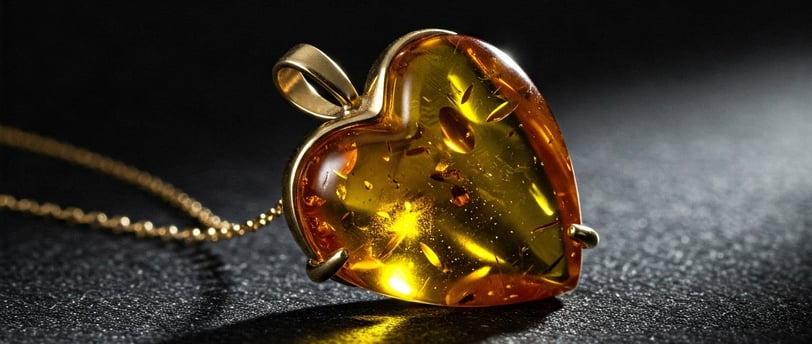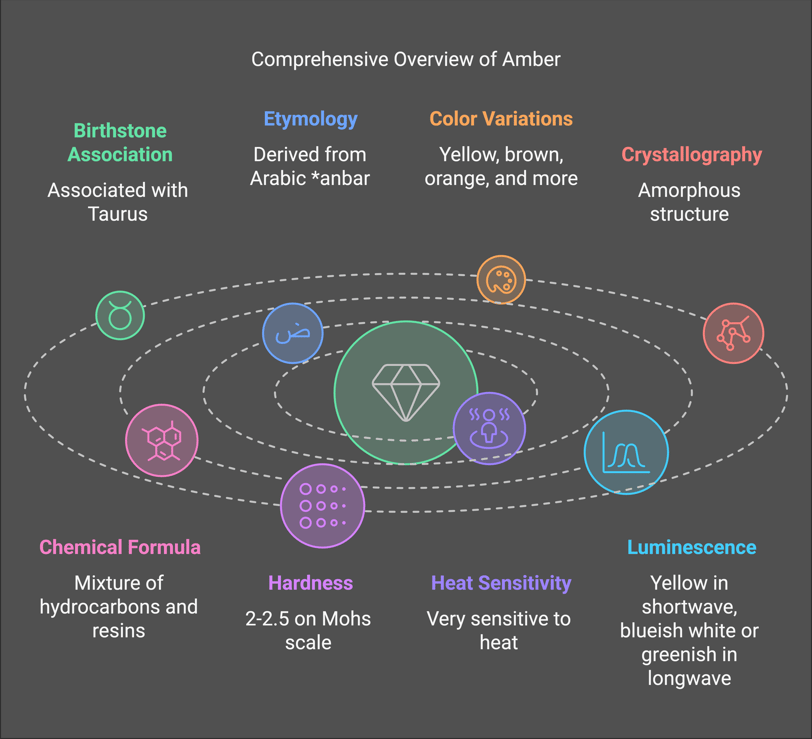Amber
Delve into the world of amber, from its origins as tree resin to its use in jewellery and beyond.
1/30/20254 min read


History
Amber, one of the earliest known gem materials, has captivated humanity for millennia with its bright sunshine hues. This organic substance, the hardened resin of ancient pine trees, is renowned for the fascinating inclusions of insects and plant matter it often contains. It is believed that people have been making amber jewellery for over 10,000 years, which may make it the first gem material ever used. The Greeks called it "elektron," or "made by the sun," and the Egyptians buried it in tombs for the afterlife. Amber is considered nature's time capsule because it contains remnants of life from millions of years ago, offering a window into prehistoric ecosystems. It has also been used for practical purposes such as incense and perfume. In medieval times, knights controlled the European amber trade and possession of its raw form was banned for commoners.
Mineral Origins
Amber is not a mineral but an organic substance formed from fossilized tree resin. Most of this substance comes from the preserved resin of the pine species Pinus succinifera, although other ancient tree species have also produced the material. Amber is at least 30 million years old. The oldest amber dates back approximately 320 million years. While commonly referred to as fossilized resin, amber's organic materials haven't been replaced by minerals. Instead, the resin has undergone a chemical transformation into a polymer, a natural plastic.
The 4 Cs
Colour
Amber is most commonly found in shades of yellow, orange, and brown. However, it can also be found in white, reddish brown, and rarely, blue or green. Deep yellow colours command higher prices. Natural cherry-red pieces are very rare and sell at a premium, though most red amber undergoes heat treatment to achieve this colour. Some amber may exhibit a bluish or greenish fluorescence, which can be highly valuable. Oxidation may cause the material to change colour over time, and cutting and polishing amber for jewelry can make it more susceptible to oxidation. Fine translucent yellow or orange amber can gradually darken to reddish brown and eventually black.
Clarity
Highly transparent amber is rare and more valuable, while opaque amber is generally carved or burned as incense. Amber often contains bubbles, which reduce its clarity. Inclusions of plants, while valuable to scientists, do not usually add value for jewelry. The inclusions that most commonly add value are insects and other animals. Transparent amber is more valuable than cloudy material; however, interesting plant or animal inclusions can increase the value of an amber specimen. Treatment can clarify cloudy amber, which may result in crack-like circular marks called sun spangles.
Carat
Large amber pieces are rare. Amber is surprisingly light, which makes it suitable for large beads or pendants that are comfortable to wear. It can even float in a saturated salt solution. Amber is commonly sold by grams, not carats. One gram is equal to five carats. Much of the large amber material on the market is reconstituted from smaller pieces.
Cut
Most amber is polished in free-form shapes, cabochons, or beads, or it may be carved. Faceted amber is rare, and typically reserved for collectors.
Be Aware Of
Enhancements
To improve clarity and colour, amber often receives heat treatment, which can create red and green amber or produce "sun spots". Coatings and dyes can also alter or improve the colour, but these less durable enhancements can wear off with time. Some pieces have copal or resin fillings to obscure cracks. Some red and green amber may fade with exposure to strong light. Heat treatment can cause the colour of amber to darken.
Simulants
Copal, another tree resin, is the most common amber imitation. Copal is younger than amber, having formed only thousands of years ago or more recently. Plastic and glass can also imitate amber. When purchasing amber, beware of "preserved" modern species. Also, some dealers insert modern insects into pressed or reconstructed amber.
Synthetics
"Genuine amber" refers to melted or pressed together amber pieces, also called ambroid, pressed, reconstructed, or bonded amber. This material is of lower value to collectors, though it is often sold at lower prices for consumers looking for larger specimens. Ambroid or pressed amber is created when small fragments of genuine amber are welded into a single form.
Final Thoughts
Buying Tips
When purchasing amber, ensure you are buying from a reputable dealer and ask about any treatments. For significant purchases, an independent laboratory report can confirm that the amber is natural and that an inclusion has not been added later. Be wary of perfect-looking insect inclusions, as the insects in amber are millions of years old and not generally perfect. Baltic amber is generally more valued than amber from other places. When buying amber, remember that the most valuable pieces have visible insect inclusions, light colours, and clarity. The colour of green amber is usually a result of heat and pressure treatment.
Jewellery Care
Because of amber's softness and sensitivity to household chemicals, pendants and earrings are the best jewellery choices. Amber can create static electricity, which attracts dust particles that may scratch it. Regular cleaning with a soft cloth can minimise damage to this gem. Avoid rough handling, heat, and chemicals. Do not store amber on top of electronics or in strong light. Keep amber away from heat as it can melt or burn in high temperatures. Warm soapy water is always a safe cleaning method. Avoid wearing amber while applying soaps, detergents, shampoos, perfumes, or commercial cleaning agents. These harsh compounds tend to dull the gemstone’s finish and leave a white residue. Never use an ultrasonic or steam cleaner. To restore the sheen, polish the stones with a high-quality olive oil.


Gemius Stones
Expertise
© 2025. All rights reserved.
